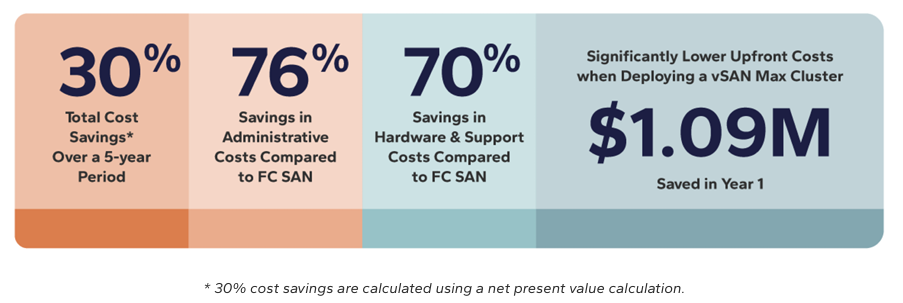With the release of VMware Cloud Foundation (VCF) 9.0, VMware Cloud Service Providers (VCSPs) have an exciting opportunity to deliver next-generation private cloud solutions more efficiently and profitably, thanks to deeper integration and strategic licensing advantages of VMware vSAN.
Historically, some providers opted out of deploying vSAN due to cost considerations or architectural preferences. However, as many VCSPs standardize on the VCF software stack, vSAN is getting a fresh look and for good reason (Read the blog, to know more about vSAN in VCF 9.0). The included 1 TiB of vSAN per core licensing for vSAN within VCF dramatically shifts the TCO (Total Cost Ownership) equation and is compelling many partners to re-evaluate their architecture and storage strategies.
vSAN + VCF 9.0 = High Performance + High ROI
If you’re already a long-time vSAN user or more recently adopted the vSAN Express Storage Architecture (ESA) you likely know its strengths which is high performance, scalability, resiliency, and operational flexibility. These capabilities make vSAN ESA particularly well-suited for dedicated and multi-tenant private cloud environments. You can start small for single-tenant workloads, and scale seamlessly to support multi-petabyte clusters all while maintaining performance and availability.
This consistency and scalability are critical for VCSPs looking to deliver private clouds of various sizes based on a single architectural model. vSAN-powered environments enable improved ROI by tailoring infrastructure precisely to customer needs, ensuring better financial predictability and higher margin potential.
Lowering Total Cost of Ownership (TCO)
One of the most significant advantages vSAN delivers within a VCF 9.0 private cloud is its ability to directly reduce both CapEx and OpEx, thereby substantially lowering the TCO for VCSPs.
Here’s how:
Converged Infrastructure = 2 for 1 Efficiency
With vSAN, storage becomes an intrinsic part of your compute infrastructure, leveraging the local disks within ESXi hosts. This software-defined storage model eliminates the need for costly and complex external SAN or NAS infrastructure.
By consolidating compute and storage into a single platform:
- You reduce your hardware footprint
- Cut down on power, cooling, and rack space requirements
- Avoid redundant vendor licensing and support contracts
- Provide a repeatable architectural model for small to large deployments
The result is a leaner, more cost-efficient architecture that delivers the dual benefits of performance and simplicity, translating into both upfront capital savings and long-term operational advantages.
Streamlined Operations & Lower Labor Costs
Managing a separate storage stack typically requires a specialized team, additional tooling, and significant administrative overhead. vSAN changes that dynamic. As one VCSP Pinnacle Partner noted,
“We already manage the ESXi servers, they just happen to have drives in them now. The incremental time to manage the storage via vSAN is greatly reduced when compared to a traditional storage array”
This integration allows a single operations team to manage both compute and storage, reducing the skill silo effect and flattening operational complexity.
And when combined with VCF’s robust Lifecycle Management (LCM) capabilities and infrastructure-as-code automation, VCSPs can:
- Automate Day 0 to Day 2 storage operations
- Reduce manual intervention in patching/upgrading
- Achieve faster storage provisioning and patching for both compute and storage
This significantly lowers staffing requirements and support costs, while also improving service delivery speed and consistency.
The Strategic Case for vSAN in VCF 9.0
In today’s competitive cloud landscape, VCSPs must deliver agility, performance, and profitability. VCF 9.0 combined with vSAN gives you all three. Whether you’re building out small-scale, high-margin customer pods or large-scale, multi-tenant platforms, the architectural consistency, reduced operational complexity, and improved economics of vSAN make it a compelling choice.
More importantly, this isn’t just about infrastructure, it’s about unlocking new business models with predictable cost structures, simplified operations, and the ability to offer differentiated services at scale.
Elastic, Pay-As-You-Grow Model
Why buy storage now when you can buy it later. Traditional storage models often require large upfront investments and overprovisioning “just in case.” vSAN removes this constraint with a modular, scalable approach that aligns infrastructure growth with actual demand.
Whether serving a small customer tenant or scaling to multi-petabyte environments, VCSPs can:
- Start with a minimal storage footprint
- Scale horizontally by adding nodes and internal disks
- Ensure cost efficiency at every stage of growth
This elastic consumption model leads to better resource utilization, cost alignment with customer revenue, and higher ROI over time.
Faster Deployments, Better SLAs
The combination of integrated lifecycle management, automated cluster builds, and native storage policies within vSAN deliver granular control over performance, availability, and other storage characteristics at the VM level, optimizing resource utilization and simplifying consistent enforcement management for diverse workloads.
VCSPs benefit from:
- Accelerated time-to-market for customer environments with unified storage controls.
- Faster incident response and root cause analysis due to tighter integration between compute, network and storage managed through VCF Operations
- Stretched clusters that bring higher data resiliency with zero data loss options providers can deliver for customers with critical application requirements
- Fewer moving parts, which means less downtime and fewer misconfigurations
Ultimately, this translates into higher service availability, improved SLA adherence, and greater customer satisfaction, which are critical drivers for long-term client retention.
TCO Reduction That Powers Business Growth
With vSAN as the foundation for your VCF 9.0 deployments, you’re not just optimizing your infrastructure you’re maximizing business outcomes. From lower upfront CapEx and reduced operational overhead, to faster ROI and improved margins, the TCO advantages of vSAN directly support your growth and competitiveness in the cloud market. Your finance team will see improvements in Time to Value that vSAN brings to your organization.

Source: Signal65, The Economics of Disaggregated Private Cloud Storage Total Cost of Ownership Analysis of VMware vSAN and Fibre Channel SAN, In Partnership with VMware by Broadcom, July 2024
Final Thoughts
As VCSP partners continue to embrace VCF 9.0, vSAN is proving to be more than just a storage platform; it’s becoming a strategic enabler of private cloud innovation. By combining software-defined storage with a unified lifecycle approach and integrated enforcement management, partners are transforming their operations, improving margins, and delivering more value to their customers.
Now is the time to re-evaluate how vSAN in VCF 9.0 fits into your cloud strategy. With the right architecture, tools, and pricing model your cloud can be more agile, cost-efficient, and scalable than ever before.
Next Steps
To view the complete report and better understand how VMware vSAN can lower storage costs during your private cloud transformation, read the complete report on Signal65’s website.
Read the blog to learn more about how vSAN outperforms traditional storage arrays.
A special thanks to Steve Lord for co-authoring this blog with me and for contributing his deep domain expertise.




